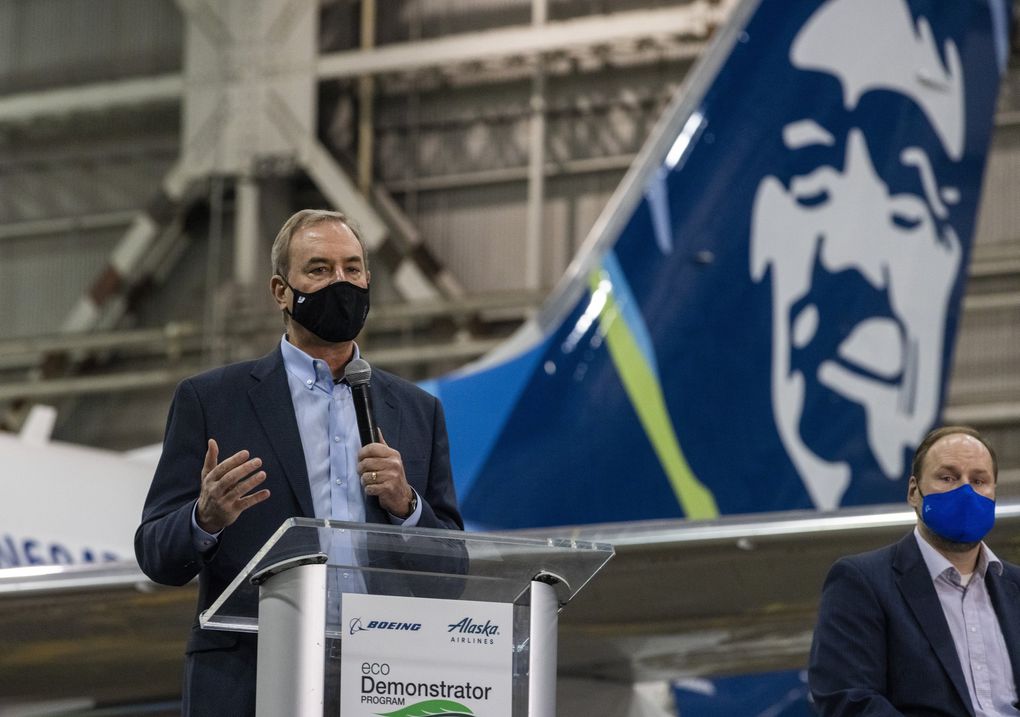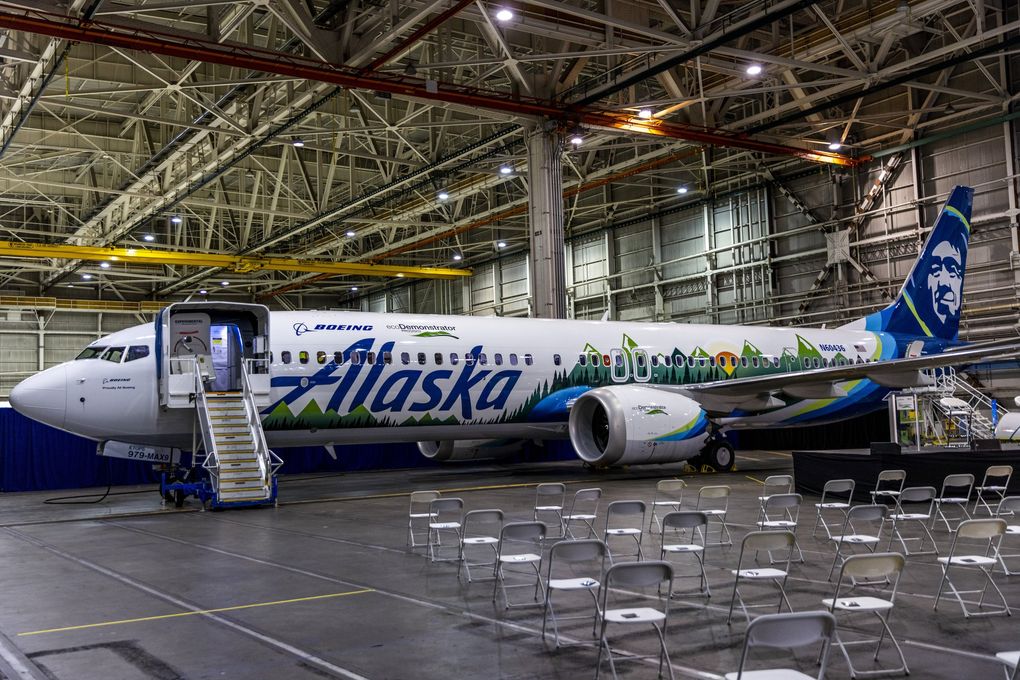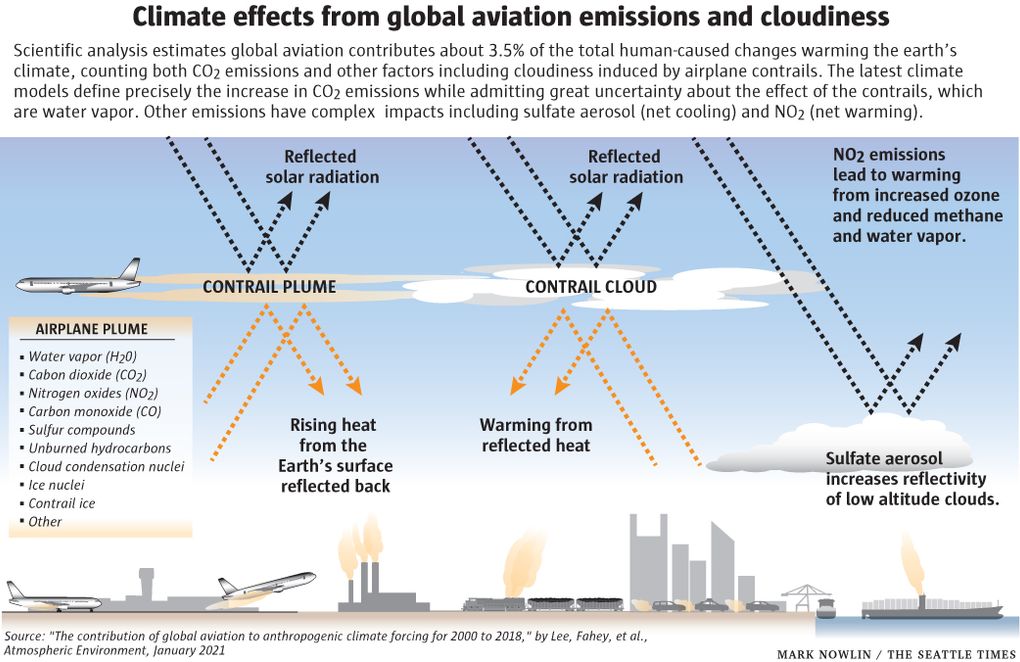As aviation struggles to emerge from the historic, pandemic-driven downturn, another longer-term challenge already looms. Concern about air travel’s contribution to climate change threatens to curtail growth of an industry that has expanded steadily for decades, shrinking the world for travelers and connecting the global economy.
The airline industry, contending with growing political pressure in Europe and recently even in Seattle for new restrictions on flying, this month formally committed to a target of “net zero” carbon emissions by 2050.
To achieve that, governments and industry will have to invest billions of dollars in infrastructure in the coming decade. Further out, Boeing and Airbus will have to develop dramatically new airplane designs.
For the flying public, all outcomes in the years ahead point to an increase in the cost of flying.
Yet that distant net-zero emissions target is so radical, and the proposed technology solutions so uncertain, that aviation risks falling far short.
Airbus CEO Guillaume Faury recently warned that if the industry’s new push for climate sustainability fails, governments could force a reduction in air travel by banning some of the flying that is routine today — a major step back after more than 100 years of passenger flights.
“Aviation has a very important role on the planet to connect people and to contribute to prosperity,” he said at a two-day aviation sustainability summit convened by Airbus in France last month. “We are at a point where this is in danger if we don’t manage to transition and succeed in the decarbonization of the sector.”
This is “the number one matter of discussion in the industry, even more than COVID now,” he added.
Under pressure, the world’s major airlines have firmly committed to one key technology that will dominate aviation’s environmental push in the coming decade: Sustainable Aviation Fuel, or SAF.
For the plane manufacturers, the major costs and big risks will come later.
In the coming decade, Airbus and Boeing will make money from the airlines’ push for sustainability by promoting the sale of new, more efficient jets to replace older planes that burn more gas and produce more carbon emissions. But further out, the plane builders will need to develop dramatically new technologies.
Airbus is already aggressively pursuing research to develop by 2035 a zero-emission, short-haul airliner powered with hydrogen. That research is largely funded by European governments.
Boeing contends that hydrogen-powered aircraft won’t be realistic until as late as 2050. But as Mike Sinnett, Boeing vice president of product development, recently said, “whatever the next airplane is, we recognize sustainability is going to be a driving factor.”
After the world’s airlines announced the new “net zero by 2050” goal at this month’s annual conference of the International Air Transport Association, IATA Director General Willie Walsh demanded a big technology leap from Airbus and Boeing.
“It’s not good enough that we get incremental change in efficiency with the aircraft,” Walsh said. “To get to net zero we’re going to need a fundamental change.”


Climate campaigns
The latest definitive scientific study estimates that aviation contributes a net 3.5% of total human-induced climate impact. Cleaning it up has become a focus of those who see an existential crisis in climate change.
“There is a limited time for a life-altering change for my generation and my children’s generation,” said Sarah Shifley, a lawyer who volunteers on the aviation team of climate activist group 350 Seattle.

This summer, 350 Seattle mounted a campaign opposing a planned expansion of flights at Boeing Field, where corporate jets and cargo aircraft, as well as Boeing delivery and test flights, fly in and out.
Locally, the Puget Sound Regional Council that makes long-term decisions about transportation needs — and is weighing the need for one or more new airports — projects takeoffs and landings in the region will double by 2050 to over 800,000. In similar fashion, Boeing projects the world’s fleet of airliners doubling by 2040, driven by growth in emerging economies.
That’s an appalling prospect to Shifley.
“After the summer we’ve had, of heat domes and hurricanes and floods and fires, it’s unfathomable to me to be considering doubling” air traffic, she said.
Elsewhere, particularly in Europe, flying is already being curbed by government policy. France in April banned domestic flights between cities with a train connection of less than 2.5 hours. Various government agencies and organizations around Europe have imposed similar bans on short-haul flights for employee business travel.
At the Airbus sustainability summit, Andrew Murphy, aviation director at Transport & Environment, a nonprofit that campaigns for clean transportation, said planned expansion of airports in Europe should stop.
He called for mandates with strict timelines to spur the decarbonization of aviation.
“What would drive innovation and drive focus in the sector is if we were to say, by 2035, we will end the sale of jet aircraft for short-haul flights in Europe,” Murphy said.
Ross Macfarlane, a vice president at both the Sierra Club and the Clean Energy Transition Institute, which seeks to cut carbon emissions out of the Pacific Northwest economy, said the U.S. needs to look at high-speed rail and other alternatives to flying.
He said the COVID-19 lockdown has demonstrated there are “ways to do business that are frankly more efficient than jumping on a plane at the drop of a hat.”
Yet he acknowledges how critical aviation is to modern life and the global economy. “It’s both unrealistic and not in society’s interest to take a stance of simply advocating for aviation to go away. It’s not going to happen,” he said.
Science and uncertainty
Jet airplane engines burn a lot of fuel. Alaska Airlines alone burns 750 million gallons per year.
Alaska provided data for a Boeing 737-900ER flight Oct. 6 from Seattle to Philadelphia: It burned 4,388 gallons of jet fuel, or about 24 gallons per passenger, counting bags and some extra cargo.
Yet driving that 2,800-mile trip in a typical family car would use about 112 gallons of gas, making it less fuel efficient even with four people in the car.
The most recent comprehensive scientific analysis of aviation’s impact on the atmosphere over time — published in January in the journal Atmospheric Environment and cited by both climate activists and the industry — estimated the sector’s contribution as 3.5% of total human-induced climate change based on 2011 global flight data.
That’s the same percentage calculated by the U.N.’s Intergovernmental Panel on Climate Change more than two decades ago based on 1992 flight data.
Though aviation grew enormously between 1992 and 2011 as the world’s fleet of airliners more than doubled, the increasingly efficient airplanes burned less fuel. Meanwhile, other human-induced climate impacts grew as fast so that percentage contribution was constant.
Sean Newsum, director of environmental sustainability strategy at Boeing, said one can infer “that aviation emissions are growing at a rate no greater than the global emissions overall.”
The Atmospheric Environment analysis estimates that only a third of aviation’s 3.5% net contribution to climate change is from its CO2 emissions, with the largest contribution coming from airplane contrails.
A jet contrail — the line of what looks like white smoke that sometimes trails an airplane — is not an emission from the airplane. It’s water vapor that is already in the air around the plane that’s triggered to condense, forming ice particles.
While contrails often disappear completely in a short period, under certain atmospheric conditions they persist as diffuse cirrus clouds that reflect back terrestrial radiation, with a net warming effect.
The conclusion that aviation’s non-CO2 impact on the climate — mostly from contrails, but also from soot particles, nitrogen oxides and other trace emissions — is twice as large as that from its CO2 emissions alone is often cited with alarm by climate activists.
However, there’s great scientific uncertainty around the climate impact of the non-CO2 emissions.
A lead author of the Atmospheric Environment paper, David Fahey of the National Oceanic and Atmospheric Administration in Boulder, Colorado, said in an interview that modeling the effect of contrails is complex, producing calculations with such wide probability ranges that the warming impact is “of uncertain magnitude.”
Speaking at the Airbus sustainability summit, another leading climate expert, Drew Shindell, professor of earth science at Duke University, said the impact of contrails “really is still up for debate in the scientific community” and is “probably not such an enormous problem.”
That suggests aviation’s total net contribution to climate change could be significantly less than 3.5% of the total human-induced impact.
Fahey said climate scientists aim to provide policymakers the best available data, while also laying out all the uncertainties.
“People are throwing rocks at aviation,” he said. “It’s complicated.”
Hydrogen power
At the 2021 United Nations Climate Change Conference, known as COP26, which convenes at the end of this month in Glasgow, Scotland, countries around the world will commit to new targets to lower emissions.
As a global business, aviation has until now fallen outside the scope of those national targets, its goals set instead by the U.N.’s International Civil Aviation Organization, which is heavily influenced by the world’s airlines.
However, as conference host, the U.K. is launching the International Aviation Climate Ambition Coalition in Glasgow to try to get more countries to sign a substantive declaration on aviation emissions.
Clearly, if aviation is to avoid regional restrictions being imposed on flying, major industry players will have to convince the public and governments that they are taking real action.
Airbus CEO Faury is confident his engineers will have a hydrogen-powered short-haul airplane ready by 2035, though the jet maker won’t have to commit significant investment of its own until it formally launches an airplane program around 2027.
At the IATA conference in Boston, Boeing Commercial Airplanes chief Stan Deal expressed his doubts that hydrogen-powered airliners can be ready in that time frame.
First, there’s the complexity of a totally new airplane design. Deal pointed out that liquid hydrogen occupies 18% more volume than current jet fuel and must be wrapped in cryogenic equipment to keep it cooled to -418°F. Designing such a system, he said, presents “some physics problems.”
Certifying it as safe to fly also will be a major hurdle. As Boeing’s Sinnett expressed it, “To have a safe system that can carry liquid hydrogen and be as safe as we are with jet fuel today, that might be bigger and heavier than you want to put on an airplane.”
Even Airbus acknowledges it will take far longer to develop hydrogen power for large, long-haul aircraft.
In addition, hydrogen production requires lots of electricity — and if that comes from a carbon-dirty source, there’s no net climate benefit in using it as fuel. So energy companies will have to vastly scale up production of “green hydrogen,” produced from sustainable sources.
And then airports around the world will have to invest in the cryogenic tank infrastructure and equipment needed to dispense the liquid hydrogen to airplanes.
Hydrogen, Sinnett said, “is not ready for prime time yet. It’s a longer-term play.”
While Boeing has worked with NASA on various futuristic “green airplane” concepts, for now it offers the prospect of only incremental technology tweaks to its current planes.
Otherwise, it promotes SAF as the potential solution to aviation’s climate impact — a technology being developed and paid for not by the manufacturers but by alternative energy startups with government support.
Sustainable Aviation Fuel
On that, Faury and Airbus agree: If the industry is to meet the net zero goal, it cannot wait for hydrogen and must over the next three decades dramatically scale up the use of SAF.
Yet that too is a difficult technological goal.
SAF is a hydrocarbon fuel typically produced from biomass feedstock such as waste oils or plant debris and purified so that the final liquid is essentially identical to current jet fuel.
When SAF burns in a jet engine, it produces exactly the same carbon emissions. Nevertheless, it’s deemed “sustainable” because the life cycle of those emissions shows the carbon being absorbed from the air by plants, then recycled back to the air.
This contrasts with fossil fuel, where the carbon going into the air had previously been sequestered underground for millions of years.
If SAF is carefully produced using the cleanest methods, it’s touted as providing a life-cycle reduction in carbon emissions of between 50% and 80% compared with fossil fuels.
Because SAF can be simply dropped in a tank instead of jet fuel, neither the design of the airplane nor the fueling infrastructure at the airport need to change.
The problem is producing SAF in sufficient quantities at an affordable price.
The small quantities produced today cost five to seven times as much as jet fuel. Though demonstration flights have flown on SAF, it makes up less than 1% of the aviation fuel currently used.
To hit its net zero emissions target, IATA wants that scaled up so that 65% of all aviation fuel is SAF by 2050.
Macfarlane of the Sierra Club believes SAF can work, while acknowledging that “skepticism is well justified.”
“There are many proposals out there for biofuels that would be used for aviation, that aren’t sustainable and aren’t really scalable,” he said.
Identifying truly sustainable sources is problematic. Imported palm oil, for example, the cause of deforestation in Southeast Asia, is unacceptable. And producers must consider what land use is displaced by growing the feedstock.
Still, momentum and investment are building to overcome these obstacles. Multiple SAF projects are in the works in the U.S. and around the world.
Oil giant Shell has committed to produce 2 million metric tons of SAF per year by 2025, though to be clear, that’s less than 1% of aviation’s annual fuel needs.
The Bend, Oregon-based U.S. subsidiary of alternative fuels startup SkyNRG plans to build a plant for producing such jet fuel out of landfill waste. Boeing has a deal with SkyNRG to tap that proposed facility for its own aviation fuel needs.
The Department of Energy in September awarded $64.7 million in new funding for biofuels, with SkyNRG getting $1 million of that.
With coal and gas climate change provisions already cut from President Joe Biden’s proposed social spending legislation, Sen. Maria Cantwell is pushing to retain $1 billion for SAF research and tax credits so as to stimulate production of 3 billion gallons of SAF per year in the U.S. by 2030 — about 10% of U.S. airline fuel needs.
Major companies keen to burnish their own sustainability credentials are putting money into jump-starting SAF production.
Microsoft has agreed to pay Alaska Airlines for SAF, expensive as it is, to be used on certain West Coast routes frequently flown by its employees.
At the Airbus summit, John Holland-Kaye, CEO of London’s Heathrow Airport, said that without sustainability “we won’t have a business.”
“It may well be that the flying does cost a little bit more,” he said. “But that will be a price worth paying.”
from WordPress https://ift.tt/3mauH75
via IFTTT



No comments:
Post a Comment